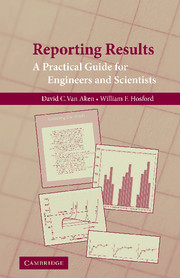Book contents
- Frontmatter
- Contents
- Preface
- REPORTING RESULTS
- 1 Elements of Technical Writing
- 2 Technical Papers
- 3 Technical Letters
- 4 Oral Presentations
- 5 Presentation of Technical Data
- 6 Statistical Analysis of Experimental Data
- 7 Resumé Writing
- Appendix I COMMON ERRORS IN WRITING
- Appendix II PUNCTUATION
- Appendix III COMMON WORD ERRORS
- Appendix IV INTERNATIONAL SYSTEM OF PREFIXES AND UNITS
- Appendix V THE GREEK ALPHABET AND TYPICAL USES
- Appendix VI STRAIGHT-LINE PLOTS FOR SOME MATHEMATICAL FUNCTIONS
- References
- Index
6 - Statistical Analysis of Experimental Data
Published online by Cambridge University Press: 05 September 2012
- Frontmatter
- Contents
- Preface
- REPORTING RESULTS
- 1 Elements of Technical Writing
- 2 Technical Papers
- 3 Technical Letters
- 4 Oral Presentations
- 5 Presentation of Technical Data
- 6 Statistical Analysis of Experimental Data
- 7 Resumé Writing
- Appendix I COMMON ERRORS IN WRITING
- Appendix II PUNCTUATION
- Appendix III COMMON WORD ERRORS
- Appendix IV INTERNATIONAL SYSTEM OF PREFIXES AND UNITS
- Appendix V THE GREEK ALPHABET AND TYPICAL USES
- Appendix VI STRAIGHT-LINE PLOTS FOR SOME MATHEMATICAL FUNCTIONS
- References
- Index
Summary
This chapter is an introduction to statistical analysis. Reporting of average values relative to a trend line does not convey the significance of a measurement. Calculation of uncertainty or confidence levels is required. This chapter discusses Gaussian and Weibull distributions, which are the two most commonly used in science and engineering. The chapter concludes with a discussion of uncertainty analysis where reported values and confidence levels depend on one or more measured quantities. This chapter is not meant to be a complete work on statistical analysis. It should, however, provide the necessary background for undergraduate students to include statistical analysis when writing lab reports. The professional may also find this chapter a useful resource when writing technical reports.
Errors and Calibration
Random and systematic are the two principal types of errors that occur during experimental measurements. Random errors, sometimes called accidental errors, may be introduced by variations in the instruments or by the person making the measurement. For random errors, positive and negative deviations occur with equal probability. If the measurements are biased toward either positive or negative deviations, then a systematic error may be present. Either the instrument or the person making the measurement can introduce both random and systematic errors. When random errors occur, a statistical analysis of the measurements is often used to determine the precision or uncertainty of the measurement. Accuracy of the measurement can only be determined by measuring a standard of known value.
- Type
- Chapter
- Information
- Reporting ResultsA Practical Guide for Engineers and Scientists, pp. 82 - 110Publisher: Cambridge University PressPrint publication year: 2008



